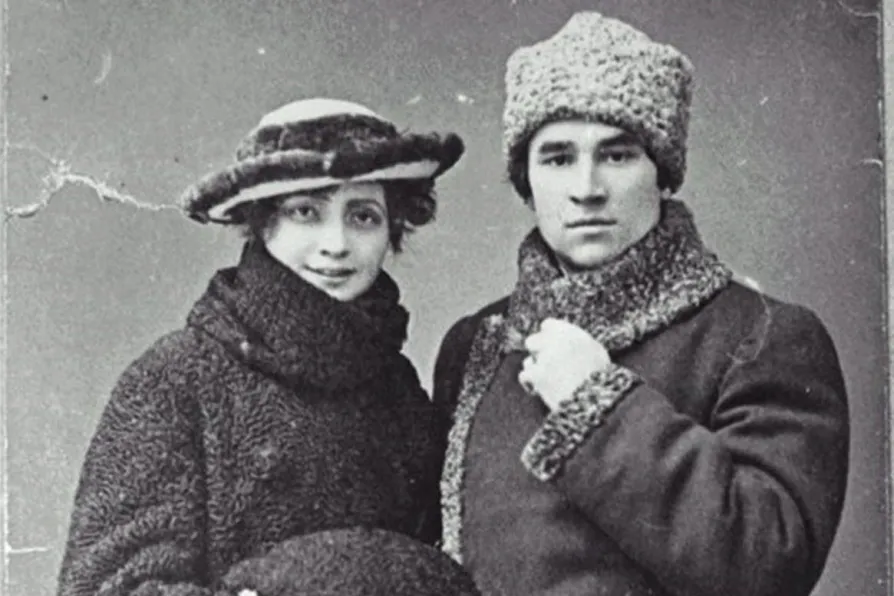From London’s holly-sellers to Engels’s flaming Christmas centrepiece, the plum pudding was more than festive fare in Victorian Britain, says KEITH FLETT
The Tatar rebel argued that Western workers could be bought off, so instead a ‘colonial international’ must form a dictatorship over Europe and the US, ideas that led to his expulsion from the Bolsheviks and eventual execution, writes EDMUND GRIFFITHS

 THIRD WORLD FIRST: The Tartar revolutionary who advocated for the colonised nations to lead, seen here with his wife Fatma Erzin in 1919
THIRD WORLD FIRST: The Tartar revolutionary who advocated for the colonised nations to lead, seen here with his wife Fatma Erzin in 1919
WHEN Mirsaid Sultan-Galiev was arrested in early 1923, he became the first Bolshevik politician to go from a disagreement with Stalin to the inside of a police cell.
Zinoviev would remark that this was the moment when “Stalin tasted blood,” but, as yet, very little blood was shed. Sultan-Galiev was expelled from the Bolshevik Party, but no charges were brought.
In 1928, he was arrested again and sent to a prison camp in the far north; released in 1934, he was arrested a third time in 1937 and ultimately shot in 1940. Numerous alleged “Soltanghalievites” were also jailed and executed.
Today, however, Sultan-Galiev looks like a remarkable forerunner of “third worldism.”
He was born in 1892 as the son of an impoverished Tatar schoolteacher in what is now Bashkortostan.
He attended teacher training college in Kazan, and it was probably there that he first encountered revolutionary ideas. Soon, he had co-founded an underground socialist group, printing Tatar-language proclamations on an illegal duplicating machine.
In 1917, he joined the Bolshevik Party, where his enormous capacity for administrative work earned him a string of responsible positions in the party and the Soviet state.
Sultan-Galiev played a central role in defusing an attempt by Tatar bourgeois parties to proclaim their own regional autonomy.
He also committed an entirely private, non-political murder: he shot a man who had had an affair with his wife. Bolshevik leaders knew about it, but the episode was hushed up.
The outbreak of the civil war saw Sultan-Galiev heading the Central Muslim Military Collegium, tasked with recruiting Muslims to the Red Army.
At first, many Tatars still sympathised with the bourgeois democratic parties. Admiral Kolchak’s putsch in late 1918 clarified that a liberal, federal Russia was no longer an option: White victory would mean a dictatorship of extreme Russian chauvinists.
But another factor that helped reconcile Muslims to the Soviet cause was intervention by the Western Allies, above all Britain and France.
Soltanghaliev’s civil war-era speeches and writings stress repeatedly that the Bolsheviks’ enemies are the imperialist powers — the oppressors of Muslims in Afghanistan, India, Egypt and north Africa. His appeal found a ready response.
The distinguished Tatar religious scholar Musa Jarullah Bigiev — hitherto a supporter of the liberal Ittifaq party — toured with Barkatullah Bhopali, an Indian revolutionary, urging Muslims to support the Red Army against world imperialism.
At one point, half the Red soldiers fighting on the Siberian front against Kolchak were Muslims.
Sultan-Galiev wrote that “Tatar Red Army fighters were the pioneers of the social revolution in the East, carrying the red banner of class struggle into the remote villages of Central Asia, the tents of Siberia, and the mountain hamlets of the Caucasus.”
An autonomous Tatar republic was established in 1920, although Tatars made up only a bare majority of its population — and millions were left outside “their” republic.
The Tatar section of the Bolshevik Party, meanwhile, was convulsed by factional struggles pitting the “left” — who saw national autonomy as unimportant in a Soviet state — against Sultan-Galiev and the “right,” who prioritised cultural and economic decolonisation.
Sultan-Galiev argued that Islam — overwhelmingly a religion of colonised peoples, with bitter experience of overbearing Tsarist administrators and missionaries — had to be treated with special tact.
Ranting speeches and demonstrative mistreatment of the Koran were unlikely to produce the desired effect; a gentler approach — say, a few well-chosen anecdotes satirising Russian priests — might do better (“you know what, our mullahs are just the same…”).
For a time, the Soviet authorities did seem to take that message to heart.
One striking example in Kazan came when permission was granted for an elegant brick mosque to be built in what until 1917 had been the Russian part of the city — the decolonising imperative taking priority here over the struggle against religion.
In general, however, Sultan-Galiev became increasingly disillusioned with the reality of Soviet decolonisation.
He reported from Crimea in 1921 that the Soviet order seemed no better, to the peninsula’s Tatar peasantry, than a continuation of colonialism. In fact, it was worse: the old bourgeois holiday spots on the coast had at least bought produce from local growers, but the new workers’ health resorts just requisitioned what they needed.
In 1922, when Russia and other Soviet republics merged into the USSR, it turned out that none of the Muslim republics was yet eligible to become a full member state.
Russian chauvinism seemed to have survived the transition from tsarism to Bolshevism.
It was rarely as blatant as it had been in central Asia during the October Revolution, when power had been seized by a Tashkent Soviet representing Russian workers and soldiers exclusively.
Sometimes it was camouflaged as a high-minded unwillingness to take national and colonial issues very seriously. But he thought he recognised it for what it was.
Sultan-Galiev also criticised Bolshevik leaders for focusing on the Western proletariat — whose revolutionary potential he doubted — and ignoring the revolution in Asia.
The Western bourgeoisie exploited not only its “own” proletariat, but its colonies too: it could always satisfy local workers’ economic demands at the colonies’ expense.
If revolution did nonetheless break out in a Western metropolis, but not in the colonies, the ruling class could play — entirely cynically — on justified anti-Western feelings to mobilise a counter-revolutionary colonial army.
Something similar had been tried during the Russian civil war, when imperialist powers had supported bourgeois nationalist movements among Russia’s subject peoples.
Finally, even a successful revolution in the West would not automatically end colonial exploitation.
A British workers’ state would still want to import raw cotton from India and sell manufactured goods back.
Sultan-Galiev was probably thinking of Soviet central Asia, which found itself still growing cotton for Russian textile factories. His calls to develop indigenous industries in regions of primary production had fallen on deaf ears.
These considerations led Sultan-Galiev to his most radical and most characteristic slogan: the dictatorship of the colonies and semi-colonies over the metropolises.
He envisaged a new party, the Colonial International, uniting the non-Western peoples and establishing a revolutionary dictatorship over western Europe and its North American offshoot.
It might seek allies inside the West (he mentioned anarchists and communist splinter groups), but the leading role would be played by the colonised peoples themselves.
Within the USSR, Russian chauvinism would only be overcome when the “hegemony of the Russian people” was replaced by a “dictatorship of the other peoples over the Russians.”
This programme may strike us as ambitious, but perhaps it did not seem wholly fantastical 100 years ago.
The Russian revolution of 1905 had been followed not by revolution in western Europe but by a string of revolutions across much of Asia: Iran in 1906, Ottoman Turkey in 1908, China in 1911.
A similar chain reaction need not have looked impossible in the 1920s. And this time the revolutionaries’ demands would have been more advanced, their ranks stiffened by Muslim Red Army units fresh from beating Kolchak: why should the movement for liberation not have swept on into India, Egypt and beyond?
Commentators have wondered whether Sultan-Galiev was “really” a communist or a nationalist, “really” a pan-Islamist or “really” a pan-Turkist. The question is almost certainly wrongly posed.
He once remarked that the Bolsheviks endorsed “the national liberation movement in the colonies and semi-colonies, but at the same time we talked about the need to fight pan-Turkism, pan-Islamism and pan-Asianism. That’s like saying we need to support the class struggle of the European proletariat, but we also need to fight communism.”
All these movements seem to have interested him primarily as practical weapons that could be used in the worldwide struggle for liberation.
No organised Soltanghalievite group continued after the 1920s; but his name has never been quite forgotten. The Algerian and Egyptian leaders, Ahmed Ben Bella and Gamal Abdel Nasser, are said to have been admirers.
He might be better known today if the factional politics of the Sino-Soviet split had played out differently: as it was, the people who could have been most receptive to Soltanghaliev’s ideas have usually presented themselves as loyal followers of Stalin, for whom a victim of the camps was inevitably an unattractive role model.
Few, anyway, are likely to embrace all Soltanghaliev’s views and decisions now. But many of the issues that preoccupied him — issues of imperialism, colonialism and liberation — are as relevant today as ever.










